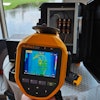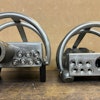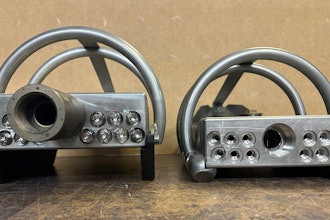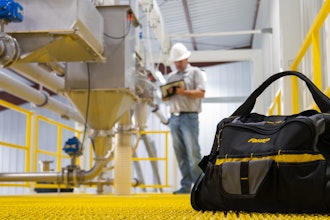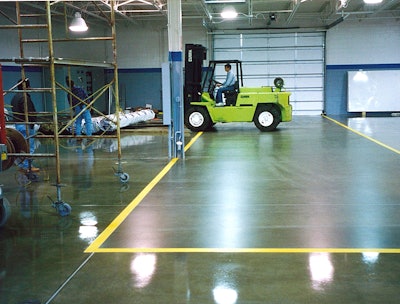
Your loading dock is likely to be one of the busiest areas in your commercial or industrial facility, with the dock floor doubtlessly being subjected to more punishment than any other traffic surface. Nearly everything, whether a raw material, a piece of equipment or a manufactured product—either on its way in or out—goes through the loading dock. These items are transported by a no-letup stream of forklifts, dollies, and hand trucks, accompanied by their drivers, the dock workers who load and unload the shipments, and the pedestrians who monitor the supply chain and distribution.
Yet all of those dock floor “stressors” simply have to do with movement and traffic. Added to these are challenges having to do with the location of the facility and the types of raw materials and products being used. For example:
- Bay doors, depending on the weather and security demands, may be left ajar during working hours or may be constantly opened and closed throughout the day. In regions where outdoor temperatures can vary drastically from the indoor environment, concrete dock flooring near large overhead doorways may experience severe thermal stress.
- In regions with consistently high outdoor relative humidity, drier and/or cooler interior air can cause condensation to settle on the dock floor, resulting in the concrete slab and indoor traffic surfaces bring constantly moist or wet, especially near loading dock doorways.
- Similarly, entryway floors are often exposed to moisture from outdoor precipitation being blown in by the wind or tracked in by pedestrians.
- Every facility occasionally experiences broken pallets, spills resulting from dropped containers and/or equipment leaks. Depending on the type of operation and what it produces or handles, there may be a range of harsh chemicals and corrosives, oils, solvents, fuels, and so on, dripped or spilled on the floor, in either liquid or powder form.
The Importance of the Finish for Your Loading Dock Floor
Porous by nature, the concrete substrate of a loading dock can withstand only so much of this constant barrage on its own. Unprotected concrete, when continually exposed to heavy stressors, can begin to exhibit various types of deterioration, including spalls, potholes, nicks, cracks and unevenness.
Such damage can end up requiring costly repairs to the concrete surface or to the slab itself, as well as repair or replacement of equipment. Additionally, damaged flooring can also create dangerous conditions for pedestrians, resulting in accidents, downtime, legal actions, and a lowering of operational efficiency and productivity.
As tough as a concrete floor surface may look, it is often the high-performance coating system that protects and defends it from the multitude of forces in play.
Where to Start When Selecting a Finish for Your Loading Dock
In the same way you perform a scrupulous needs assessment before purchasing items for other areas of your facility, a thorough analysis of the demands to be placed on your loading dock can best inform your selection of protective flooring. This should include:
- Measuring the volume and type of traffic—equipment and pedestrian—to which the loading dock will likely be subjected during a particular period of time: If you are running several shifts, the traffic type and volume can vary and should be measured separately. The weight of loaded forklifts and pallet jacks should also play a role. Accounting only for the lowest common denominator will not reveal what is needed to adequately protect your loading dock floor, and you might be surprised to discover which shift has the highest volumes of certain types of traffic. These measurements can be critical in determining the level of durability, strength and abrasion resistance the floor will need.
- Developing a comprehensive list of materials that make their way through the loading dock: This can include a broad spectrum of raw materials, fuels and fluids used in equipment, cleaning solutions, solvents and a host of other substances. While packaging is, of course, designed to protect against breakage, accidents causing spills, drips and seepage are certainly not unknown. If your facility works with or produces extreme pH acids or alkalis, harsh chemicals, or any substances that could corrode exposed concrete, it can be particularly important to consider these when selecting loading dock flooring protection.
- Taking local weather conditions into account: The greater the fluctuations in temperature and/or the greater the difference in relative humidity inside versus outside the facility, the more you will need to ensure your loading dock floor is protected against thermal stress and thermal cycling, as well as potential condensation and wet floor conditions. This can also be a factor in determining the level of traction that will be required. The greater the chance of wet or moist floor surface conditions, the greater the slip-and-fall risks to workers and facility visitors, and the greater the possibility of equipment skidding or having a hard time stopping.
Recommended Types of Finishes for Loading Dock Floors
Urethane and epoxy resin based systems are among the most proven concrete floor finishes for commercial and industrial facilities, both on the loading dock and throughout the building. When carefully selected and installed, epoxy coatings can provide outstanding protection to high traffic loading docks. Urethane flooring systems of both the thin film and cementitious mortar varieties, furnish a different set of protective advantages. When the two are used in a combined system, epoxies and urethanes can be hard to beat.
What Epoxies Have to Offer
The long list of the benefits offered by epoxy floor coating systems makes it easy to see why these materials have been such facility favorites for so long. The performance features include:
- A high level of durability and abrasion resistance—Flooring has a long usable life, even in the face of high volumes of both pedestrian and vehicular traffic.
- Easy maintenance—Epoxy requires no waxing, buffing or polishing, and so utilizes fewer human, maintenance product and energy resources to maintain. This environmental feature aligns with many companies’ eco-friendly corporate image.
- Available in a variety of sheens, as well as a broad range of standard and custom colors—The large selection supports not only design aesthetics and branding, but enables facilities to safely route traffic with the use of traffic lines and color-coded pathways. Highly reflective gloss floors in lighter colors can brighten an otherwise dark workspace or corridor, reflecting sufficient overhead illumination and improving visibility sufficiently so as to reduce the need for additional fixtures and energy consumption.
- Shock absorbency, when installed with impact-dispersing aggregate components and/or elastomeric underlayment capable of absorbing vibration—Despite its apparent hardness, some cured epoxy flooring systems can offer great tensile and flexural strength. When installed as an aggregate-filled coating, the aggregate can help disperse impact across the floor surface. And when installed over an elastomeric underlayment, some epoxy floor coverings are capable of absorbing machine vibration to the benefit of nearby equipment and workers alike.
- Available as 100% solids resin systems, with very low or no VOCs—Compliant with federal and local VOC regulations, many epoxy floor coatings are eligible for LEED® Green Building credits.
- Customizable installation—Can be installed in such a way as to accommodate specific facility needs, which may include increasing the level of traction in a certain area of the floor with a choice of slip-resistant aggregates; controlling moisture vapor transmission with special primers or basecoats; inhibiting the growth of pathogens by way of the floor’s virtual seamlessness and integral cove base installation, as well as requesting factory added antimicrobials; selection of epoxy resin type and formulation to provide additional resistance to corrosives, extreme pH substances, harsh chemicals, fuels, oils and solvents.
Combining Layers of Urethane and Epoxy Floor Coatings
Urethanes offer a slightly different set of performance benefits than epoxies and from the standpoint of the installer, fall into two broad categories: 1) Thin film urethane topcoats, and 2) Cementitious urethane mortars. Thin film urethane topcoats can be used over compatible epoxy primers and body coats to enhance the floor’s overall abrasion, chemical and stain resistance.
Aliphatic thin film urethanes also offer greater color retention and UV resistance over time than do most epoxy resins, and can thereby help the finished floor keep its good looks throughout its useable life. Cementitious urethane mortars are perform ideally in locations where thermal shock or ongoing wet surface conditions are likely, such as near loading dock bay doors. These versatile floor coatings can also be used to help mitigate the frequently seen slab condition called Moisture Vapor Transmission (MVT).
Depending on site conditions, optimal loading dock concrete floor protection might be best achieved by combining layers of different types of urethane and epoxy coatings in a single system. Examples and benefits of these options may include:
- An epoxy primer followed by 1-2 thin film urethane topcoat(s): Because thin film urethane coatings do not adhere well when applied directly to concrete, the tenacious bond of an epoxy primer is used to help ensure good system adhesion. This type of proven general purpose protective floor system works well for many facilities.
- A cementitious urethane primer, followed by a cementitious urethane build coat, and a decorative multilayered epoxy system with optional thin film urethane topcoat: This type of floor can be ideal where MVT conditions, such as a non-functioning underslab vapor barrier, threaten the performance and appearance of almost any other type of floor covering. It looks great and can provide excellent protection in high traffic conditions over the long haul.
- A cementitious urethane primer, followed by a cementitious urethane build coat, plus a topcoat of pigmented aliphatic thin film urethane: In locations with thermal shock and thermal cycling, the Portland cement component of urethane mortar flooring will expand and contract at nearly the same rate as the concrete substrate. This helps enable tenacious bond, even during extreme temperature swings. The thin film topcoat offers good color stability and UV resistance for an aesthetically pleasing, uniform appearance.
These are just some of the ways urethane and epoxy based coatings can be used in conjunction with one another to get the best of both worlds.
Choosing the Best Products for Your Loading Dock
There are many different epoxy and urethane formulations and possible combinations. Once you have analyzed your needs, partner with a reliable manufacturer or approved installer who can guide you through the selection process and help you find the optimal solution for your facility and budget.
Sophia Daukus is Marketing Communications Manager for Florock Polymer Flooring, manufactured in Chicago, IL since 1952.

